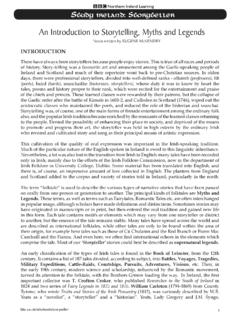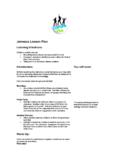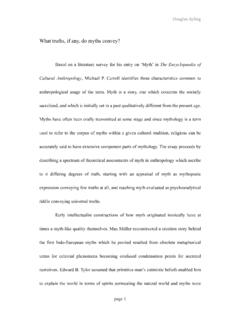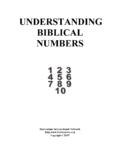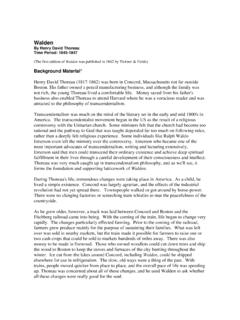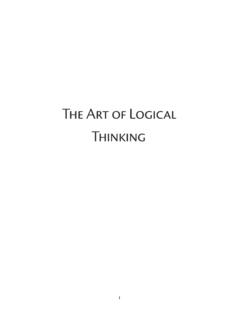Transcription of ctz rel pg01 tn - BBC - Home
1 TEACHER'S NOTES KS3/KS4. RELIGION Fast Facts BUDDHISM. PEOPLE. siddhartha gautama was born a prince, the son of a ruler of a small kingdom in northern India, at Kapilavastu in the Himalayan foothills around 560 BCE. At the age of 29 he left his wealthy privileged life to seek an answer to the problem of human suffering, wandering around as a beggar. He tried fasting and meditation, but rejected extreme solutions. According to the famous tradition siddhartha sat down in the shade of a banyan tree and after a night of meditation he began to understand the meaning of things and became enlightened, achieving nirvana. Sculptures of the Buddha, as he became known, often show him seated in meditation recalling the occasion under the banyan tree. The Buddha died at the age of 80 having in uenced many by his teachings and sermons.
2 After the Buddha's death the new teachings spread rst through northern India and over the following centuries were carried north into central Asia, southwards towards Sri Lanka and South East Asia and eastwards towards China and Japan. Some Buddhists, especially of the Tibetan tradition, refer to siddhartha gautama as the Buddha Shakyamuni, which means the sage of the Sakya clan (denoting the area of Nepal where the Buddha was born). A familiar symbol of Buddhism is the eight-spoked wheel which reminds people of the eightfold path of the Buddha's teaching. Another common symbol is the lotus ower. The roots of the lotus are in the mud at the bottom of the pond, which represents human life, while the ower itself represents enlightenment. BELIEFS. Buddhists believe in birth and rebirth and the cause and effect of karma (actions).
3 Every action has an effect and people's actions tie them to the cycle of birth and rebirth a process of endless suffering. Buddhists seek to be free from this cycle by understanding and acting on the teaching of the Buddha. These teachings are summed up by the Three Universal Truths, the Four Noble Truths and the Eightfold Path, which together are known as the Dharma. The Three Universal Truths: 1. Everything is impermanent and changing 2. Impermanence leads to suffering, making life imperfect 3. The self is not personal and unchanging. The Four Noble Truths: 1. All life involves suffering (the Truth of Suffering). 2. Suffering is caused by desire and attachment (the Origin of Suffering). 3. Desire and attachment can be overcome (the Truth of Cessation). 4.
4 The way to overcome them is by the Eightfold Path (the Truth of the Path). The Eightfold Path: 3. RELIGION. RACISM Fast Facts The Eightfold Path is eight ways of behaving and each way has to be followed because they depend on each other. They relate to wisdom, morality and meditation. 1. Right seeing and understanding the Noble Truths 2. Right thought or intention acting considerately 3. Right speech avoiding lies or gossip; saying what you mean 4. Right action honesty and not harming living things 5. Right work or livelihood avoiding jobs that harm other beings 6. Right effort seeking to overcome desire, sel shness and attachment 7. Right mindfulness thinking before acting; meditation 8. Right concentration freeing the mind of distractions before meditation Buddhists sometimes speak of their most precious beliefs as The Three Jewels belief in the Buddha, the Dharma and the community (or monastic order) of the sangha.
5 COMMUNITIES. In the period after the Buddha's death divisions arose leading to the development of two main schools of Buddhist thought the Mahayana tradition (most commonly found to the north and east of India) and the Theravada tradition (found mainly in southern and south eastern Asia). Theravada Buddhists ( the Way of the Elders') believe that the Buddha was a perfect model to imitate but only human. They do not pray to the Buddha because he can no longer help people alive now. Followers of the Theravada tradition believe that people must follow the teachings written in the Tipitaka scriptures in order to enter into nirvana. This tradition gives more emphasis to the role of monks and nuns and in some countries it is customary for boys to spend some time living as monks.
6 Mahayana Buddhists ( the Great Vehicle') believe that siddhartha was not the only Buddha others had come before him and there will be others yet to come. They believe in the bodhisattva ( enlightened essence') one who delays entry into nirvana in order to help others to gain enlightenment. Mahayana Buddhists use the Tipitaka scriptures and other more recent writings called sutras such as the Diamond Sutra and the Lotus Sutra. Not everyone needs to become a monk in Mahayana tradition and people can seek nirvana without abandoning life in society. In adapting to different cultures Mahayana Buddhism has given rise to distinct branches Vajrayana or Tibetan Buddhism (led by the exiled Dalai Lama); the Chinese Pure Land tradition centred around the compassionate Amida Buddha; and Japanese Zen Buddhism, which is very popular in the West, emphasising meditation as the way to enlightenment.
7 Both main traditions have a presence in Ireland and there is a Tibetan Buddhist centre in Co. Cavan which serves as a focal point for Irish Buddhists. PLACES OF WORSHIP. Some Buddhist temples are on a grand scale and very ornate, while others may be simple rooms set aside for worship. The rituals performed at a shrine or temple vary considerably according to the tradition of Buddhism to which it belongs and the culture of the country where it is found. The offerings of owers, candles, incense are a mark of respect. Flowers symbolise the shortness of life;. candles symbolise enlightenment; incense represents the spread of the Dharma. As a sign of respect and thankfulness for the Buddha's teaching a Buddhist may prostrate himself or herself 4. RELIGION. RACISM Fast Facts in front of the statue of the Buddha.
8 Prayer for most Buddhists is not directed to a god but is a way of getting one's thoughts in tune with the teachings of the Buddha. Prayers are often in short repeated phrases (mantras). and some Buddhists write the mantras onto a scroll which is placed in a spinning prayer wheel. The spinning of the wheel represents the repeating of the mantras and their release into the world. A community of Buddhist monks or nuns is called a sangha. The members of the sangha spend their time studying the scriptures, meditating and working, perhaps as teachers or medical carers. They live simply and may go out with a begging bowl. Buddhist families normally keep a statue of the Buddha in the home and some families have a special shrine room. They may place offerings of owers, candles, incense and food in front of the statue.
9 FESTIVALS. Different Buddhist countries and cultures have their own distinct festivals. In relation to the Western ( xed) calendar all Buddhist festivals are moveable because of being based on the lunar calendar. In general Buddhist festivals tend to be times of remembrance and reaf rmation rather than festivity. Losar is a Tibetan Buddhist festival celebrating the Buddha's early life and marks the new year. It takes place at the February full moon and people clean their homes in preparation for it, signifying a new start. Lamps are carried through homes and monks wear bright costumes and masks to scare off evil spirits. Asala marks the preaching of the Buddha's rst sermon. It is normally celebrated in July and monks preach special sermons for the occasion.
10 In Kandy, a city in Sri Lanka, it is celebrated at the festival of the Sacred Tooth during which the Buddha's tooth is paraded through the streets. Uposatha days take place each week and are traditionally the days when monks meet to reaf rm their vows. Devout lay people also make religious observances on those days, often visiting the local temple or monastery to take gifts for the monks. The most important uposatha day each month is the one which falls on the full moon. SCRIPTURES. For the rst few centuries after the Buddha's death the Buddha's teachings were conveyed by oral tradition. Various councils were held to determine what the Buddha had actually taught and it was during this period that some of the early divisions amongst Buddhists became evident.



